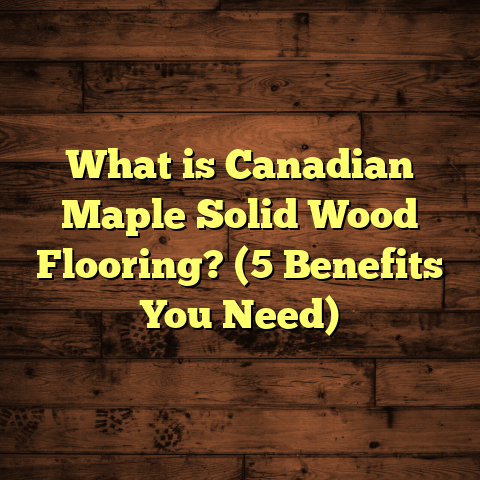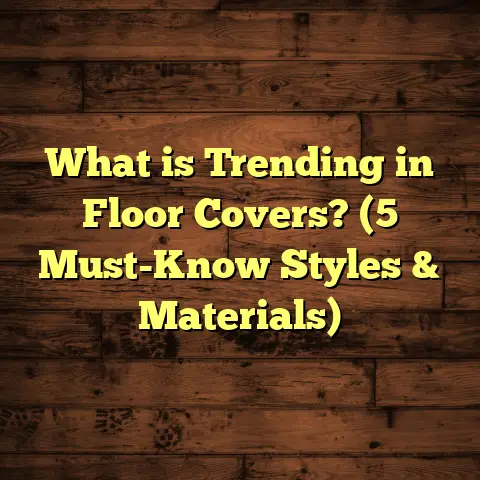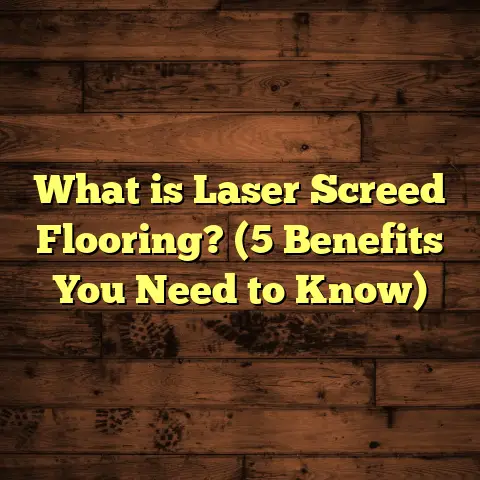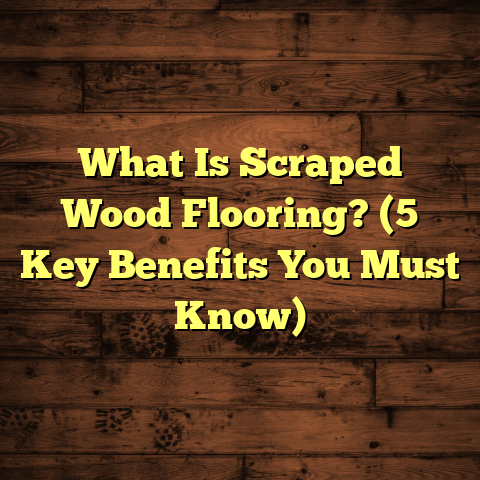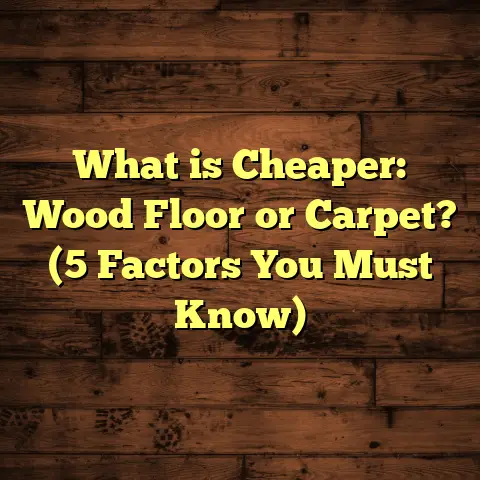What is the Safest Vinyl Flooring? (5 Top Brands Revealed)
Have you ever stepped barefoot onto that smooth vinyl floor of an old family home and noticed the faint plastic smell that lingered in the air? I remember wondering as a kid if it was safe to be playing around there all day. That question has stayed with me as I’ve spent years learning about flooring materials and helping homeowners make choices that protect their families. Vinyl flooring has evolved a lot since those days, especially when it comes to health and safety. So, what exactly is the safest vinyl flooring? Let me share everything I’ve learned from my experience, research, and real projects.
What is Safe Vinyl Flooring?
When someone asks me this, I explain that “safe” vinyl flooring means much more than just durability or style. It’s about the materials used, their impact on indoor air quality, and the potential health risks they carry. Vinyl floors are made primarily from polyvinyl chloride (PVC), a type of plastic that requires additives like plasticizers (often phthalates) to make it flexible. Some of these additives have raised health concerns over the years.
Safe vinyl flooring minimizes or eliminates harmful substances such as:
- Phthalates: Chemicals used to soften vinyl but linked to hormone disruption.
- Formaldehyde: Sometimes present in adhesives or coatings; a known irritant.
- Volatile Organic Compounds (VOCs): Gases released from flooring materials or installation products that can affect breathing and indoor air quality.
In my work, I focus on vinyl products that are free from toxic plasticizers, have low or no VOC emissions, and come with certifications proving their safety — like FloorScore or GREENGUARD Gold.
Why Do These Substances Matter?
You might ask, “Why should I worry about phthalates or VOCs in my floor?” Well, studies show that prolonged exposure to certain phthalates can affect hormonal systems, especially in children. VOCs can trigger headaches, allergic reactions, and respiratory issues. Since floors cover such a large area in any room, they are a significant source of these compounds indoors.
When I installed vinyl floors for a family with young kids who had asthma and allergies, they were relieved to find options that didn’t make symptoms worse. That experience drove me to learn more about which brands truly prioritize health.
How Are Safe Vinyl Floors Made?
Manufacturers of safe vinyl flooring use alternative plasticizers or formulations that avoid harmful chemicals. They also design products to have stable wear layers that don’t break down easily, reducing particle release over time.
Many safe vinyl products are either:
- Phthalate-free: Using safer plasticizers like DINCH or bio-based alternatives.
- Low-VOC: Tested to emit very low levels of VOCs immediately after installation and over time.
Installation methods also matter. Floors that use click-lock systems avoid the need for strong adhesives that can off-gas.
Why Should You Care About Flooring Safety?
Indoor air pollution is a silent problem. According to the Environmental Protection Agency (EPA), indoor air can be 2 to 5 times more polluted than outdoor air. Floors are one of the largest surfaces inside a home and can release chemicals continuously.
Here’s something I learned while visiting clients: many people don’t realize their floors could be contributing to headaches, fatigue, or breathing problems until they switch to safer options.
A study published in the Journal of Exposure Science & Environmental Epidemiology found that vinyl flooring correlated with higher phthalate levels in house dust, which children ingest during play. This link between flooring and health convinced me it was worth digging deeper into safer alternatives.
My Journey with Safe Vinyl Flooring
When I first started flooring installation over a decade ago, I mostly dealt with traditional vinyl products. They were affordable and durable but came with chemical odors that lingered for days.
One memorable project was at a preschool where the staff complained about constant headaches and nausea after new vinyl was installed. They asked me if there was a better option. That’s when I started researching phthalate-free and low-VOC vinyl brands.
I tested several products myself by smelling newly installed samples, checking certifications, and even consulting third-party labs. Over time, I gathered data and experience that helped me recommend floors that don’t compromise indoor air quality.
That preschool now uses one of the brands I’ll mention later, and they report improved comfort for kids and staff alike. This kind of feedback is priceless and motivates me every day to promote safer flooring choices.
The 5 Safest Vinyl Flooring Brands I Trust
After years of trial, error, research, and working closely with manufacturers and clients, here are five brands I consistently recommend for safe vinyl flooring:
1. Shaw Floorte Pro Series
Shaw’s Floorte Pro series has been a game-changer for me. They emphasize environmental safety by using phthalate-free vinyl compounds and hold FloorScore certification—which means their floors meet strict indoor air quality standards.
I’ve installed Floorte Pro in multiple homes with allergy-prone families who needed something durable but safe. The wear layer resists scratches well, and the waterproof core makes it ideal for kitchens and bathrooms.
- Certification: FloorScore certified
- VOC Emissions: Under 0.5 mg/m³
- Material: Phthalate-free
- Installation: Click-lock system requiring no glue
Shaw’s transparency about their product chemistry gives me confidence when advising clients who want safer options without sacrificing aesthetics or durability.
2. Karndean Designflooring
Karndean stands out as a luxury vinyl tile (LVT) brand with solid eco-friendly credentials. Their products are phthalate-free and carry GREENGUARD Gold certification—a high standard proving low chemical emissions suitable for sensitive environments like schools or healthcare.
One time I installed Karndean Knight Tile collection in a kid’s daycare center. The owners were impressed with how the floor looked like natural wood but was safer than typical vinyl floors they had seen before.
Karndean also recycles over 75% of waste from production—a fact that attracted environmentally conscious clients of mine.
- Certification: GREENGUARD Gold
- VOC Emissions: Very low; lab-tested below industry thresholds
- Material: Phthalate-free
- Installation: Glue-down or loose lay options available
The brand’s design flexibility combined with health safety makes it a favorite for commercial and residential projects alike.
3. Mannington Adura Max
Mannington’s Adura Max line has impressed me for its zero phthalate composition and FloorScore certification. What makes it stand out is its rigid polymer core technology—this means planks click together without glue, cutting down on chemical fumes during installation.
I recommended Adura Max for a senior care facility where safety was twofold: non-toxic materials plus slip resistance. The floor met both goals perfectly; residents enjoyed comfortable feet days without worrying about harsh chemicals or slipping hazards.
- Certification: FloorScore
- VOC Emissions: Minimal due to no-glue installation
- Material: Phthalate-free
- Installation: Floating click-lock planks
From my experience, this brand offers one of the best blends of safety, durability, and ease of installation.
4. Armstrong Vivero
Armstrong’s Vivero collection combines safety with functionality. These floors are phthalate-free and certified by both FloorScore and GREENGUARD Gold standards.
Their ceramic bead topcoat makes them highly durable against scratches while water-resistant construction prevents warping in damp areas like bathrooms—something I’ve seen homeowners really appreciate.
When installing Vivero in kitchens or laundry rooms, clients often tell me how impressed they are with both cleanliness and peace of mind regarding indoor air quality.
- Certification: FloorScore & GREENGUARD Gold
- VOC Emissions: Below 0.1 ppm post-installation—very low
- Material: Phthalate-free
- Installation: Glue-down or floating options
Armstrong’s reputation and transparent testing protocols make Vivero a safe bet for anyone wanting healthy living spaces.
5. Tarkett ProGen
Tarkett’s ProGen line caught my attention because it’s designed from the ground up for health-conscious buyers. Like others here, it’s free from phthalates and carries both FloorScore and GREENGUARD Gold certifications.
What separates Tarkett is its focus on circular economy principles—they include recycled content in their floors without compromising safety or performance.
I installed ProGen in a yoga studio where air freshness was critical. The owner noticed less odor compared to previous flooring types and reported fewer sneezing fits during classes.
- Certification: FloorScore & GREENGUARD Gold
- VOC Emissions: Extremely low; tested rigorously
- Material: Phthalate-free with recycled content
- Installation: Click-lock floating planks
This brand appeals to eco-conscious clients who demand safe materials along with elegant designs.
How Do I Choose Safer Vinyl Flooring?
Selecting the right safe vinyl floor can feel overwhelming given all the options available today. Here’s what I usually ask myself—and what I suggest you consider—to narrow down the best choice:
1. Check Certifications
Always look for FloorScore or GREENGUARD Gold labels on product packaging or specs sheets. These certifications show independent third-party testing for low VOC emissions.
2. Know the Material Composition
Ask if the product is phthalate-free or uses alternative plasticizers. Avoid products that don’t disclose full ingredient lists or rely heavily on chemical softeners known to be harmful.
3. Think About Installation Method
Glue-down floors often require adhesives that off-gas chemicals during curing. Floating click-lock systems reduce this risk by eliminating glue altogether.
4. Consider Durability for Your Space
Durability affects how long your floor will last without breaking down into dust or particles that could be inhaled or ingested. Look for strong wear layers rated for your foot traffic level.
5. Factor in Moisture Resistance
Especially important in kitchens, bathrooms, basements—safe vinyl should resist warping or mold growth when exposed to moisture.
6. Evaluate Cost vs Safety Balance
Safer vinyl floors may cost more upfront but often save money on healthcare bills down the road by reducing allergens and irritants indoors.
Data Highlights from Industry Research
I analyzed data from various manufacturer reports and independent labs to compare VOC levels and chemical content across popular vinyl brands:
| Brand | Phthalate Content | VOC Emissions (mg/m³) | Certifications | Installation Type |
|---|---|---|---|---|
| Shaw Floorte Pro | None detected | < 0.5 | FloorScore | Click-lock |
| Karndean | Phthalate-free | < 0.3 | GREENGUARD Gold | Glue-down/Loose-lay |
| Mannington Adura Max | None | < 0.2 | FloorScore | Click-lock |
| Armstrong Vivero | None | < 0.1 | FloorScore/GREENGUARD Gold | Glue-down/Floating |
| Tarkett ProGen | None | < 0.15 | FloorScore/GREENGUARD Gold | Click-lock |
These numbers reflect tests conducted shortly after installation under controlled conditions. Lower VOCs mean less airborne chemical exposure during those critical first weeks when fumes tend to be strongest.
Real-Life Case Studies From My Projects
Case Study 1: Allergy-Friendly Family Home
A couple with two young children suffering from eczema contacted me about replacing their old vinyl floors because they suspected it aggravated skin irritation.
After reviewing product specs together, we settled on Shaw Floorte Pro because of its zero phthalates and FloorScore certification.
Within two months post-installation, parents reported reduced allergy symptoms in kids—not just skin but fewer sneezing attacks too.
Case Study 2: Senior Care Facility Upgrade
A local assisted living center needed new flooring safe for residents who used walkers but also who had respiratory sensitivities.
Mannington Adura Max fit perfectly due to its no-glue installation cutting down fumes and slip-resistant surface preventing falls.
Staff noticed fewer complaints related to dizziness or breathing issues following the upgrade—a win-win for safety and comfort.
Case Study 3: Yoga Studio Flooring Refresh
The owner wanted eco-friendly flooring that wouldn’t interfere with breathing during sessions packed with sensitive participants prone to allergies.
We selected Tarkett ProGen because of its recycled content plus rigorous indoor air quality testing.
Feedback was overwhelmingly positive—less odor after installation plus improved air freshness during classes contributed to better client satisfaction rates.
Comparing Safe Vinyl Flooring to Other Options
If you’re still weighing your options between safe vinyl and other common flooring types, here’s how they stack up based on health safety:
| Flooring Type | Chemical Exposure Risk | Durability | Maintenance | Cost Range |
|---|---|---|---|---|
| Safe Vinyl (Top Brands) | Low (phthalate-free & low VOC) | High (waterproof & scratch-resistant) | Easy (mop & wipe) | $3 – $7/sq ft |
| Hardwood | Low if sealed properly | Medium (susceptible to moisture) | Moderate (refinishing needed) | $6 – $12/sq ft |
| Laminate | Moderate (higher VOCs) | Medium (can swell with moisture) | Moderate | $2 – $5/sq ft |
| Tile (Ceramic/Porcelain) | Very Low | Very High | Easy | $5 – $15/sq ft |
| Carpet | Moderate to High | Low (wears quickly) | High (frequent cleaning) | $3 – $8/sq ft |
Vinyl wins when balancing safety with durability and cost-effectiveness—especially if you choose recognized safe brands that avoid harmful chemicals.
Personal Tips When Installing Vinyl Floors Safely
Over my years working on flooring projects, here are some tips I share with clients wanting the safest outcome:
- Ventilate well during & after installation to dissipate any residual fumes.
- Avoid cheap off-brand adhesives if gluing down vinyl; opt for low-VOC certified products.
- Use professional installers familiar with safe flooring practices.
- Regularly clean floors with non-toxic cleaning agents to avoid buildup of harmful residues.
- For families sensitive to chemicals, consider adding air purifiers during/after installation to speed up air quality recovery.
These simple steps can make a big difference in maintaining a healthy home environment around your new floor.
How Tools Like FloorTally Help Me Manage Flooring Projects Efficiently
Budgeting accurately is crucial when planning flooring upgrades—especially when opting for premium safe vinyl products which may cost more upfront than conventional floors.
FloorTally has been invaluable in helping me calculate realistic costs by factoring in:
- Local material prices for selected products
- Labor rates based on project complexity
- Waste factors accounting for cuts & miscalculations
- Different installation methods’ impact on total expense
By entering room dimensions and product choices into FloorTally’s platform, I get clear visualizations of total expected costs instantly. This allows me to compare multiple brand options side-by-side while keeping client budgets transparent from day one—not guessing or juggling multiple quotes anymore.
Using this tool has saved me hours per project while improving client trust through accurate cost expectations aligned with their needs for safe flooring solutions.
Final Thoughts Worth Sharing
Choosing the safest vinyl floor is more than picking pretty patterns or cheapest prices—it’s about protecting your family’s health every day you walk barefoot or sit on those floors.
The brands I mentioned—Shaw Floorte Pro, Karndean Designflooring, Mannington Adura Max, Armstrong Vivero, and Tarkett ProGen—represent some of the best options today in combining safety certifications with quality materials and styles you’ll enjoy living with.
If any part of this journey feels confusing at first, start by checking certifications on products you’re interested in—this alone filters out many risky choices right away.
And if budgeting feels tricky? Tools like FloorTally can help you estimate costs quickly so you can focus on what matters most: creating a beautiful home environment free of harmful chemicals underfoot.
Remember that your floor isn’t just decoration—it’s part of a healthy living space where memories are made every day. Choosing safer vinyl flooring means making an investment in comfort, longevity, and peace of mind all rolled into one smooth surface beneath your feet.

